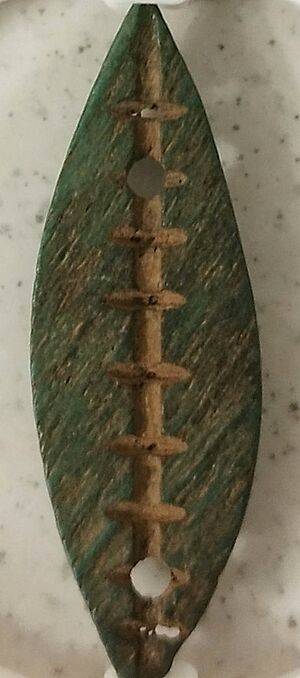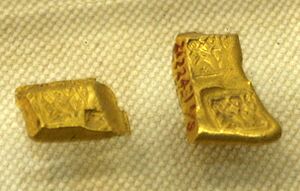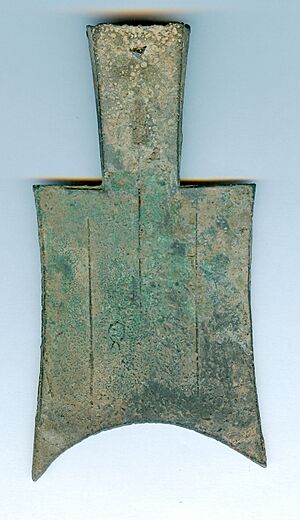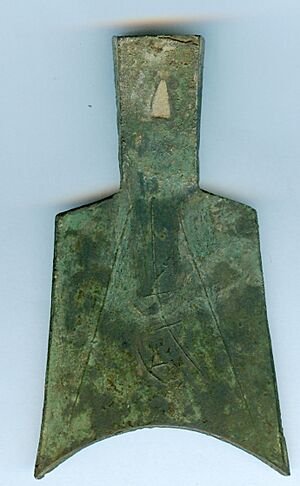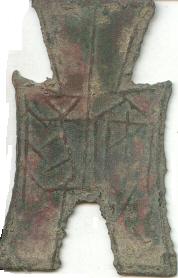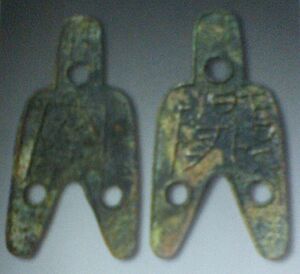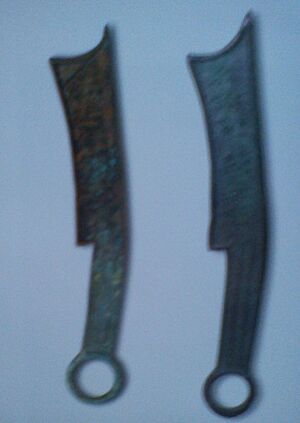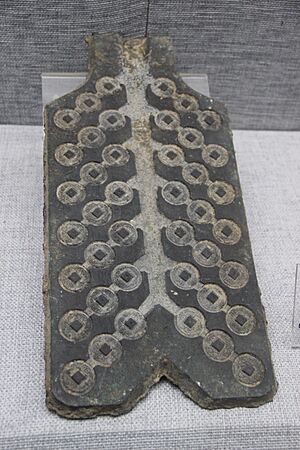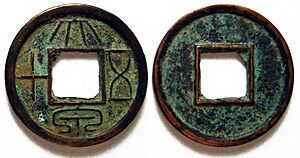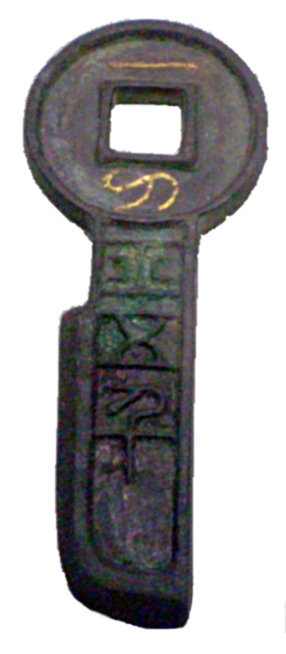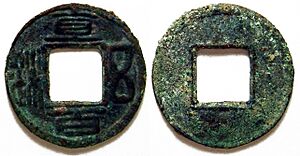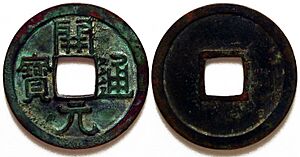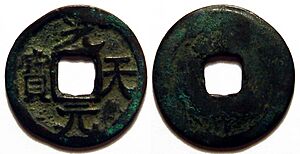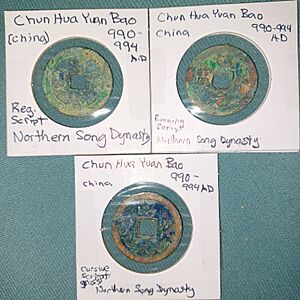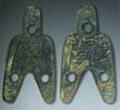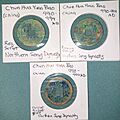Ancient Chinese coinage facts for kids
Ancient Chinese coins are some of the oldest money ever made! People in China started using them way back in the Spring and Autumn period (around 770–476 BCE). At first, these coins looked like cowrie shells, which were used for special trades. Soon after, the first metal coins appeared. But they weren't round like coins today! They were shaped like knives or spades.
Around 350 BCE, round metal coins with a hole in the middle were first used. The hole was round at first, then later square. When the Qin dynasty (221–206 BCE) united China for the first time, they made one standard type of coin for everyone. Later dynasties kept making variations of these round coins throughout China's imperial history.
At first, coins were mostly used near the capital city. But by the time of the Han dynasty, coins were used everywhere! People used them to pay taxes, salaries, and even fines.
Contents
- How Chinese Coins Were Different
- Coin Production and Value
- Early Chinese Money (Before 220 BCE)
- Qin Dynasty: Standardizing Money
- Han Dynasty: Money Everywhere
- Xin Dynasty: Wang Mang's Coin Changes
- Three Kingdoms Period: Unsettled Times
- Jin Dynasty: Brief Unity, Then More Division
- Northern and Southern Dynasties: Poor Quality Coins
- Sui Dynasty: Reunification and Reforms
- Tang Dynasty: The Kai Yuan Tong Bao Era
- Five Dynasties and Ten Kingdoms: More Disunity
- Song Dynasty: Huge Coin Production
- See also
- Images for kids
How Chinese Coins Were Different
Chinese coins were made differently from European coins. In China, coins were poured into molds to create their shape. European coins, on the other hand, were usually cut and hammered or later, milled (stamped by machines).
Most Chinese coins were made from mixtures of metals like copper, tin, and lead. They were often made from bronze, brass, or iron. Gold and silver were rarely used for everyday coins. The amount of each metal in the coins changed a lot over time.
The square hole in the middle of most Chinese coins was very useful! It allowed people to thread many coins onto a square rod. This helped smooth out any rough edges. Then, the coins could be strung together, making them easy to carry and count.
Coin Production and Value
Making coins wasn't always controlled by one central government. Many mints (places where coins are made) were spread across the country. Sometimes, private individuals also made coins. The government tried to stop this "private coining" at different times, making it illegal. But at other times, it was allowed. The value of coins also changed a lot throughout history.
Some coins were made in huge numbers. For example, during the Western Han period, about 220 million coins were made every year! Other coins were very rare and only used in small areas. For instance, only six Da Quan Wu Qian coins from the Eastern Wu dynasty (222–280) are known to exist today. Sometimes, large collections of old coins have been found. One discovery in Jiangsu had 4,000 Tai Qing Feng Le coins! Another in Zhangpu in Shaanxi found a sealed jar with 1,000 Ban Liang coins of different weights and sizes.
Early Chinese Money (Before 220 BCE)
The earliest types of money in China were described by a famous historian named Sima Qian around 100 BCE. He wrote that people used tortoise shells, cowrie shells, gold, and metal coins shaped like knives and spades.
While we don't know much about tortoise shells as money, gold and cowrie shells (real or fake) were used in southern China. We know for sure that spade and knife money were used as coins. Early spade and knife money appeared during the Spring and Autumn period (770–476 BCE).
Cowrie Shells and Their Copies
Cowrie shells were important valuable items in the Shang dynasty (around 1766 – 1154 BC). During the Zhou period, kings and nobles often gave them as gifts. Later, people made copies of cowrie shells from bone, stone, or bronze. These copies were likely used as money sometimes.
Some experts believe the first Chinese metal coins were bronze copies of cowrie shells found near Anyang, dating back to about 900 BC. However, these don't have any writing on them.
Bronze pieces with writing, called Ant Nose Money or Ghost Face Money, were definitely used as money. They've been found in southern China, in areas that were part of the State of Chu during the Warring States period. One discovery included about 16,000 pieces! Their weight varied a lot, and they often contained a lot of lead. The name "Ant Nose" comes from how the writing looks.
Gold Money
The only gold coins from this early period are called Chu gold block money. These are sheets of gold, 3–5 mm thick, with square or round stamps on them. They have been found in southern China, showing they were made by the State of Chu. The stamps often include a unit of money or weight, usually read as yuan. These gold pieces were probably used for large payments, not everyday shopping.
Spade Money: Tools to Coins
Spade money looks like the weeding tools farmers used for trading. But these metal "spades" were too thin to be real tools. They kept the hollow part where a handle would go, even though they weren't meant for farming.
- Early Spade Money: These were similar in shape to real farming tools. Some were strong enough to be used, but others were lighter and had writing on them, probably the name of the city that made them. They date back to around 1200–800 BC, with inscribed ones from about 700 BC.
- Square Shoulder Spades: These coins have square shoulders and straight feet. They have three lines on both sides. Found in central China, they date from around 650 BC. The writing on them is usually one character, which could be a number, a place name, or a clan name. These coins were not small change!
- Sloping Shoulder Spades: These are usually smaller than earlier spades and have sloping shoulders. Their writing is clearer, often with two characters. They are linked to the Kingdom of Zhou. Their smaller size suggests they were made later.
- Pointed Shoulder Spades: These spades have pointed shoulders and feet, and a long hollow handle. They are found in northern China and are thought to be from a bit later than the square shoulder spades. Their shape seems designed to be easily tied into bundles.
Flat-Handled Spade Money
These spades no longer have the hollow handle. They are generally smaller and sometimes show their value in the writing, along with place names. This suggests they were a later development, dating to the Warring States period (475–221 BC).
- Arched Foot Spades: These have an arched bottom, like an upside-down U. They often state values like half, one, or two jin (a unit of weight). They are linked to the States of Liang and Han.
- Pointed Foot Spades: These have pointed feet and a square bottom. They are clearly related to the pointed shoulder spades. Larger ones match the one jin unit, while smaller ones are often half jin. They are linked to the State of Zhao.
- Square Foot Spades: These have square feet and a square bottom. They are found in many parts of China and are linked to several states like Han, Zhao, and Yan. They were used at the same time as pointed foot spades.
- Three Hole Spades: These are rare and have holes in the handle and feet. They come in two sizes, representing "one" and "half" units. Their find spots are in eastern Shanxi and Hebei.
Knife Money: Shaped Like Blades
Knife money looks very much like the actual knives used during the Zhou period. They developed in northern China alongside spade money.
- Qi Knives: These large knives are from the State of Qi in the Shandong area. They didn't travel much outside this region. They are named by how many characters are in their writing (e.g., Three Character Knives).
- Needle Tip Knives: These knives have a long, pointed tip. They were found in Hebei province and might have been used for trade between the Chinese and the Xiongnu people.
- Pointed Tip Knives: The blade end is curved but not as long as the needle tip knives. These are linked to the State of Yan in northeastern China. Many have been found, sometimes tied in bundles.
- Ming Knives: These are generally smaller than pointed tip knives and have straighter tips. They are named after the character on them, which is often read as ming. Mints for these knives have been found near Beijing. These coins were found in many northern Chinese provinces, and even in Korea and Japan.
Early Round Coins
The round coin, which looks like the familiar "cash coin," appeared around 350 BC. These coins had a hole in the middle. Coins from the spade money areas had a round hole, while those from the knife money areas had a square hole.
Even though coins are divided into knives, spades, and round coins for study, archaeological finds show that different types often circulated together. For example, a discovery in 1981 found over 3,500 spade coins and nearly 1,200 round coins together in clay jars. This means people used various coin shapes at the same time!
Qin Dynasty: Standardizing Money
The Qin dynasty (221–206 BC) was the first to unite China. The first Chinese Emperor, Qin Shi Huang Di, is known for standardizing money. The history books say that Qin China had two types of currency: gold for the wealthy, and bronze coins called Ban Liang.
Ban Liang coins get their name from their original weight and the two characters on them, which mean "half liang." A liang was a small unit of weight, about 16 grams. So, a Ban Liang coin was supposed to weigh about 8 grams. However, the government often made coins lighter, and people also made fake ones. Because of this, Ban Liang coins come in many different sizes and styles, making them hard to date.
Archaeological finds show that Ban Liang coins were first made by the State of Qin even before the Qin dynasty united China, possibly as early as 378 BC. In one discovery in Shaanxi, a sealed jar with 1,000 Ban Liang coins of different weights was found.
At the start of the Han dynasty (around 200 BC), people were allowed to make small, light coins because the heavy Qin coins were hard to use. The official coin weight was changed several times. In 119 BC, the Ban Liang was replaced by the San Zhu (weighing 3 zhu) and then the Wu Zhu (weighing 5 zhu).
Han Dynasty: Money Everywhere
By the Han dynasty, China had a full money-based economy. People paid taxes, salaries, and fines with coins. An amazing 220 million coins were made each year! The Book of Han describes how wealthy this period was: "The granaries in the cities and the countryside were full and the government treasuries were running over with wealth. In the capital the strings of cash had been stacked up by the hundreds of millions until the cords that bound them had rotted away and they could no longer be counted."
A laborer could earn 150 cash a month, and a merchant could earn 2,000 cash a month.
Important Han Dynasty Coins
- The San Zhu (meaning "Three Zhu" – about 1.95 grams) was issued around 140-136 BC or 119-118 BC.
- The Wu Zhu (meaning "Five Zhu" – about 3.25 grams) was first issued in 118 BC. This coin type was so successful that it was used for over 700 years by many different rulers! Most Wu Zhu coins are hard to date exactly, but some can be identified by their style or where they were found. Early Western Han Wu Zhu coins have a square top on the right part of the zhu character, while later ones have a rounded top.
- Jun Guo Wu Zhu (118–115 BC): A large, heavy coin. The government ordered these to be made with a circular rim to prevent people from clipping off bits of copper.
- Chi Ze Wu Zhu (115–113 BC): A lighter coin with filed edges. "Chi Ze" means "Red Edge," referring to the copper showing when the edges were smoothed.
- Shang Lin San Guan Wu Zhu (from 113 BC): These coins were made by three special offices in Shang Lin Park. Their quality was so high that it was hard for people to make fake ones. All older coins were melted down to make these new ones.
- Wu Zhu Coins (AD 25 onwards): Even after the short Wang Mang period, Wu Zhu coins continued to be made. They were used in large amounts and were the normal way to measure wealth. They were issued until the end of the sixth century.
- The Si Chu Wu Zhu (meaning "Four Corner five zhu") has four lines on the back radiating from the corners of the hole. It was made around AD 186. Some say the four lines meant wealth flowing from a ruined city, a sign of the Han dynasty's end.
Xin Dynasty: Wang Mang's Coin Changes
Wang Mang took over the throne in AD 9 and started the short-lived Xin dynasty. He tried to change the money system many times, but it caused a lot of confusion.
In AD 7, he kept the Wu Zhu coin but brought back two types of knife money:
- Yi Dao Ping Wu Qian (meaning "One Knife Worth Five Thousand") with gold inlaid characters.
- Qi Dao Wu Bai (meaning "Inscribed Knife Five Hundred")
Between AD 9 and 10, he introduced a very complicated system that included tortoise shells, cowries, gold, silver, six types of round copper coins, and ten types of spade money!
Some of Wang Mang's Coins (AD 9–14):
- Xiao Quan Zhi Yi (Small Coin, Value One)
- Da Quan Wu Shi (Large Coin, Fifty) - a round coin worth fifty Wu Zhu.
Some of Wang Mang's Spade Money (AD 10–14):
- Xiao Bu Yi Bai (Small Spade, One Hundred)
- Da Bu Heng Qian (Large Spade, Weight One Thousand)
These changes caused big problems. People were confused, and the new coins didn't circulate well. They secretly kept using the old Wu Zhu coins. Wang Mang was very strict and even threatened to exile people who used the old coins. This led to trade and farming suffering, and food became scarce.
In AD 14, all these complicated coins were stopped. They were replaced by a new type of spade coin called Huo Bu (Money Spade) and new round coins called Huo Quan (Wealth/Money Coin). The Huo Quan coin was so popular that it continued to be made even after Wang Mang died!
Wang Mang's failed money reforms eventually led to an uprising, and he was killed by rebels in AD 23.
Three Kingdoms Period: Unsettled Times
After the Han dynasty ended in 220 AD, China entered a long period of fighting and disunity called the Three Kingdoms period. Three main states ruled different parts of China: Cao Wei in the north, Shu Han in the west, and Eastern Wu in the east. The coins from this time show how unstable things were, with many small and token coins.
Shu Han Coins
- Zhi Bai Wu Zhu (Value One Hundred Wu Zhu)
- Zhi Bai (Value One Hundred) - These were made when Liu Bei, a leader of Shu Han, took Chengdu in 214 AD. He needed money for his troops.
- Tai Ping Bai Qian (Taiping One Hundred Cash) - These often have patterns like stars and waves on the back.
Eastern Wu Coins
- Da Quan Wu Bai (Large Coin Five Hundred)
- Da Quan Dang Qian (Large Coin Worth a Thousand)
- Da Quan Wu Qian (Large Coin, Five Thousand) - Only six of these are known to exist, making them extremely rare!
In 236 AD, Sun Quan, the ruler of Wu, made the Da Quan Wu Bai coins. He asked people to give their copper to the government to make new coins, which helped stop illegal coining.
Jin Dynasty: Brief Unity, Then More Division
The Jin dynasty reunited China for a short time starting in 265 AD. However, historical records don't mention many new coins being made during this period. In the south, coins became lighter, causing prices to jump, so people used cloth and grain instead of money. In the north, many independent kingdoms (the Sixteen Kingdoms) made their own interesting coins.
Northern and Southern Dynasties: Poor Quality Coins
This was another long period of disunity in China. The north and south were ruled by different dynasties. During this time, coins started to have more than just their weight written on them, like names or year titles. While the Wu Zhu coin was still made, the overall quality of coins was very poor.
In 465 AD, people were allowed to make their own coins. The result was tiny "goose eye" coins that were so light they wouldn't sink in water and would break easily. People didn't even bother counting them in the market; they just grabbed handfuls! A peck of rice could cost 10,000 of these cheap coins.
Southern Dynasties Coins (Examples)
- Si Zhu (Four Zhu): Issued by Emperor Wen in 430 AD.
- Tai Qing Feng Le (Tai Qing, Prosperous and Happy): Attributed to Emperor Wu (547–549 AD). A discovery in Jiangsu found 4,000 of these coins, showing they were real money, not just charms.
- Tai Huo Liu Zhu (The Large Coin Six Zhu): Issued by Emperor Xuan in 579 AD. At first, one of these was worth ten Wu Zhus, but its value quickly dropped to one.
Northern Dynasties Coins (Examples)
- Tai He Wu Zhu (Taihe [period] Wu Zhu): Issued in 495 AD by Emperor Xiao Wen of the Northern Wei dynasty. Before this, the nomadic tribes in the north didn't need much money.
- Yong An Wu Zhu (Yong An [period] Wu Zhu): First issued in 529 AD. These continued to be made under the Eastern and Western Wei dynasties.
- Chang Ping Wu Zhu (The Constant and Regular Wu Zhu): Made by Emperor Wen Xuan in 553 AD. These were finely crafted coins.
- Bu Quan (Spade Coin): Issued in 561 AD by Emperor Wu of the Northern Zhou dynasty. One was supposed to be worth five Wu Zhus.
- Wu Xing Da Bu (The Large Coin of the Five Elements): Issued in 574 AD by Emperor Wu. These were meant to be worth ten Bu Quans, but illegal coining quickly made them lose value.
- Yong Tong Wan Guo (Everlasting Circulation in Ten Thousand Kingdoms): Issued in 579 AD.
These last three coins from the Northern Zhou are known for their beautiful calligraphy, often called the Yu Zhu (jade chopstick) style.
Sui Dynasty: Reunification and Reforms
China was reunited under the Sui dynasty (581–618 AD). This short dynasty started many important reforms that helped the next dynasty, the Tang, succeed. The only coin linked to the Sui dynasty is a Wu Zhu coin. The government tried to control coin quality, but after 605 AD, private coining again caused problems.
Tang Dynasty: The Kai Yuan Tong Bao Era
The Kai Yuan Tong Bao (meaning "The Inaugural Currency") was the main coin of the Tang dynasty. It was made for almost 300 years! It was first issued in 621 AD. Its weight was set at 2.4 zhu, with ten coins equaling one liang. The famous calligrapher Ouyang Xun wrote the words on the coin, which are still admired today. This was also the first coin to use the phrase "tong bao," which appeared on many coins after it.
Making coins and getting copper was controlled by the government, and making fake coins was punishable by death. For the first time, there were clear rules for what metals to use: 83% copper, 15% lead, and 2% tin.
You can often find a crescent-shaped mark on the back of Kai Yuan coins. A popular story says that Empress Wende accidentally pressed her fingernail into a wax model of the coin, and the mark was kept! More likely, these marks were a way for mint workers to control quality.
Over time, the quality of coins got worse because of fakes. The government tried to stop this, but it was hard. By 834 AD, fewer coins were being made because copper was scarce.
In 845 AD, during the Huichang period, Emperor Wu Zong ordered the destruction of Buddhist monasteries. The copper bells, gongs, and statues were melted down to make coins in different areas. These coins, called Huichang Kai Yuans, were not as well made as the earlier ones. However, the next emperor reversed this policy, and the new coins were melted down to make Buddhist statues again.
Other Tang Dynasty Coins
- Qian Feng Quan Bao (666 AD): This coin was made to solve a copper shortage. One Qian Feng coin was supposed to be worth ten old coins, even though it weighed the same as a single coin. This led to many fakes, and the coin was stopped after only a year.
- Qian Yuan zhong bao (758 AD): These were issued to pay the army fighting against rebels. The first ones were worth 10 ordinary cash. Later, larger ones were made, worth 50 cash. These larger coins have a double rim on the back. After many people were executed for making fakes, the large Qian Yuan coins were devalued.
Five Dynasties and Ten Kingdoms: More Disunity
After the Tang dynasty fell in 907 AD, China entered another period of disunity. Five dynasties ruled in the north, and ten different kingdoms ruled in the south. There wasn't enough copper, so it was hard to make enough coins. In 955 AD, an order was given to ban owning most bronze items, except for certain things like weapons and mirrors. Anyone hoarding more than 5 jin (a unit of weight) of bronze could be executed!
The southern kingdoms had better conditions and saw more trade. They made a wide variety of coins, including large ones and those made from cheaper metals.
Later Zhou Coins
- Zhou Yuan tong bao (955 AD): These coins were made by Emperor Shi Zong. They were made from melted-down bronze statues from Buddhist temples. The emperor famously said that Buddha wouldn't mind this sacrifice. These coins are believed to have special charm-like properties because of their origin, especially for helping with childbirth!
Former Shu Coins
- Yong Ping yuan bao
- Guang Tian yuan bao
These coins were often of very poor quality. The ruler, Wang Jian, started as a village thief but rose to become a powerful ruler.
Min Kingdom Coins
- Kai Yuan tong bao (922 AD): These were made of iron and sometimes had a large dot or the character Min (for Fujian) on the back. Lead versions were also made.
- Yong Long tong bao (942 AD): Made of iron, these large coins were worth 10 small coins and 100 lead coins. A string of 500 of these poorly made iron coins was nicknamed a "manacle" because they were so heavy and inconvenient.
Chu Kingdom Coins
- Tian Ce Fu Bao (911 AD): Made of iron. The ruler, Ma Yin, who was originally a carpenter, made these coins to celebrate his new rank.
- Qian Feng Quan Bao (925 AD): Made of iron. These were worth ten copper cash and were mainly used in Changsha.
Later Shu Coins
- Guang Zheng tong bao (from 938 AD): Made of bronze and iron. Iron coins started being made in 956 AD to pay for military expenses.
Southern Tang Coins
- Yong Tong Quan Huo (after 959 AD): These large coins were made to help the army when the ruler, Yuan Zong, was short on money. One was equal to ten smaller coins.
- Tang Guo tong bao (959 AD): These coins were written in different styles, including seal script.
- Da Tang tong bao (959 AD): Also written in li script.
Southern Han Coins
- Qian Heng tong bao
- Qian Heng zhong bao (917 AD): Made from bronze and lead. The ruler, Liu Yan, set up his capital in Canton (now Guangzhou).
Crude Lead Coins
Many simple lead coins were made unofficially by merchants or people in the Southern Han/Chu area (900–971 AD). They were often based on Tang dynasty coins but had a local style. Some had series numbers or crescents on the back. The characters were sometimes reversed or meaningless because the workers weren't skilled at engraving the molds. These coins were often found in large hoards in towns.
Song Dynasty: Huge Coin Production
In 960 AD, General Zhao Kuangyin became emperor and started the Song dynasty. Coins became the main form of money. With new copper mines, coins were made on a massive scale. By 1078-1085 AD, 17 different mints produced over five million strings of bronze coins each year! The largest mint in Guangdong made 800,000 strings a year. The coin alloy was set at 64% copper, 27% lead, and 9% tin, which was less copper than the Tang dynasty coins.
Because so many official coins were available, making fake coins wasn't a big problem. Song coins were even used in many other parts of Asia, like Korea, Japan, and Indonesia.
Song coins often had new inscriptions when the period title changed. Many inscriptions were written by the emperors themselves, who were famous scholars and calligraphers. This resulted in some of the most beautiful writing on coins.
Iron coins were widely used in Sichuan and Shaanxi, where copper was hard to find. In 1005 AD, four mints in Sichuan made over 500,000 strings of iron coins a year.
Emperor Tai Zu (960–976)
- Song Yuan tong bao: First made in 960 AD. It was based on the Kai Yuan coin and weighed about 1 qian. Iron coins were also made in Sichuan.
Emperor Tai Zong (976–997)
- Tai Ping tong bao (976–989): Made of bronze and iron. Large iron coins were made in Fujian and were worth 3 bronze coins.
- Chun Hua yuan bao (990–994): Written in regular, running, and grass script. There were also small and large iron coins.
- Zhi Dao yuan bao (995–997): Written in regular, running, and grass script. The inscriptions were written by Emperor Tai Zong himself, who was a famous calligrapher.
Emperor Zhen Zong (998–1022)
- Xian Ping yuan bao (998–1003): Made of bronze and iron.
- Jing De yuan bao (1004–07): Made of bronze or iron. Large iron coins were worth 2 or 10 times the value.
- Xiang Fu yuan bao (1008–1016): Made of bronze or iron, in medium and large sizes.
- Tian Xi tong bao (1017–1022): Made of bronze or iron. At this time, there were many copper and iron coin mints across China.
Emperor Ren Zong (1022–1063)
- Tian Sheng yuan bao (1023–1031): Written in seal, regular, and li script.
- Huang Song tong bao (1039–1054): Uses seal and regular script, with many variations. Made of iron, in small or large characters. These coins were issued for many years.
- Qing Li zhong bao (1041–1048): Large bronze and iron coins. The large bronze coins were meant to be worth 10 cash, but they caused prices to rise. The large iron coins were later devalued.
See also
- History of Chinese currency
- China Numismatic Museum
- China Numismatic Society
- Jin dynasty coinage (1115–1234)
- Kucha coinage
- Liao dynasty coinage
- List of Chinese cash coins by inscription
- Sycee (yuanbao), the gold and silver ingots also used as currency under imperial China
- Western Xia coinage
Images for kids
-
A one hua coin from Yan.
-
A Western Han Ban Liang, displaying the inscription 半兩 written right to left on the obverse and a blank reverse.
-
Han dynasty coin mould



